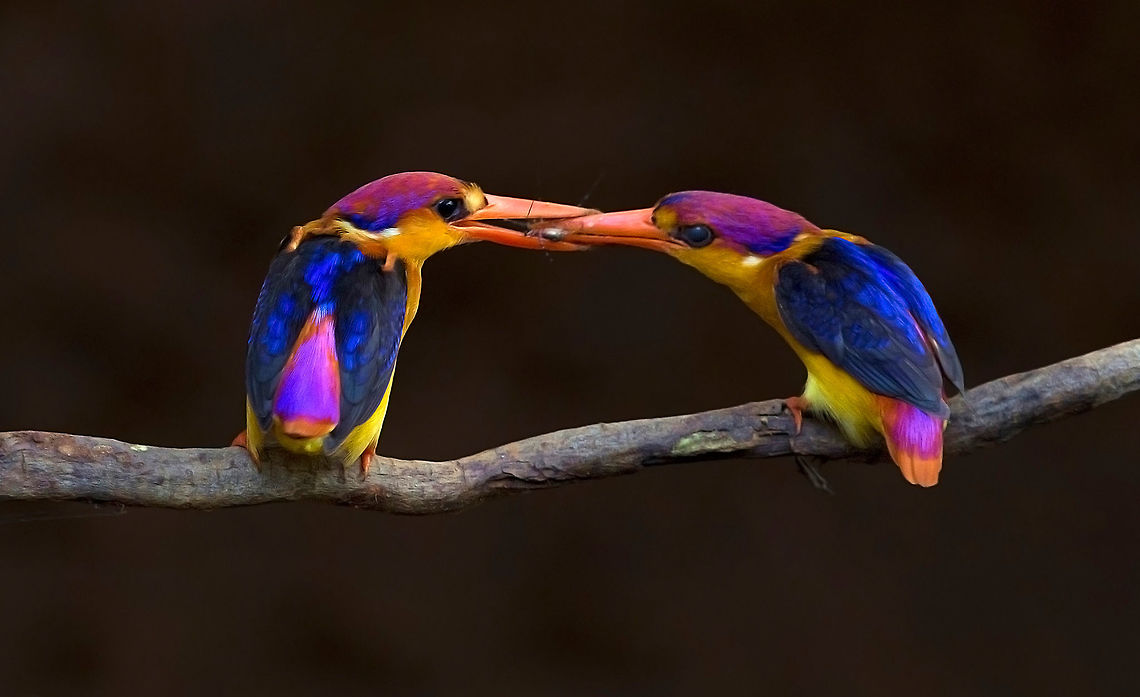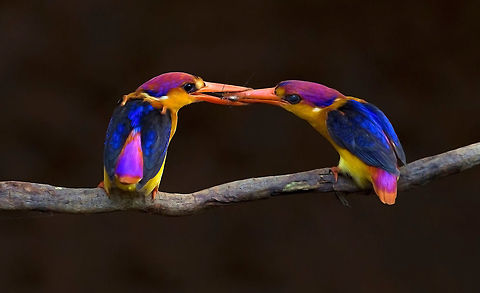 Promoted
Promoted
Oriental Dwarf Kingfisher (Ceyx erithaca)
'A Gift of Love'
The monsoon is the time when Sanjay Gandhi National Park, Mumbai, transforms into a paradise for nature lovers, this is when Aditya Salekar spotted this pair of Oriental Dwarf Kingfishers (Ceyx erithaca) engaged in a classic courtship ritual. The male bird, in customary fashion, feeds the female, before being allowed to mate with her.
Breeding / Nesting
In southwestern India, they begin to breed in June - with the onset of the Southwest Monsoon. In other areas, their breeding season stretches from October to December.
The nest is a horizontal tunnel or burrow on a bank up to a meter in length. The nests are constructed by both males and females. They will take turns burrowing out a tunnel with their feet, and then they will hollow out a narrow chamber at the end of the tunnel in which to lay their eggs. The birds will spend between three and seven days working to complete their tunnel. Some birds attack their worksites so forcefully that they have fatally injured themselves as they fly into the tunnels during these excavations. Nests constructed in hard, less penetrable ground will have tunnels that are shorter than those dug into sand or soft soil. Kingfishers are fiercely territorial in defense of their nests.
The clutch usually consists of 3 to 6 eggs, which are incubated by both the male and female for about 17 days. The chicks are fed with geckos, skinks, snails, frogs, crickets and dragonflies.
The hatchlings are altricial (without any down, blind and helpless) and they require care and feeding by the parents, who bring the food into the nesting chamber and keep them warm. However, the nestlings grow quickly and soon they are able to travel toward the entrance of the tunnel where they encounter the adults and wait to be fed. Eventually, they are fed on a perch near the entrance. Fledging can last a few days to a few weeks. After that, the chicks will be on their own and will feed themselves.
The young fledge (leave the nest) when they are about 20 days old. A second brood may be raised if the first nesting attempt was unsuccessful.

The Oriental dwarf kingfisher, also known as the black-backed kingfisher or three-toed kingfisher, is a species of bird in the family Alcedinidae. A widespread resident of lowland forest, it is endemic across much of the Indian subcontinent and Southeast Asia. It is found in Bangladesh, Bhutan, Brunei, Cambodia, India, Indonesia, Laos, Malaysia, Myanmar, Singapore, Sri Lanka, and Thailand.

comments (14)
Our week focusing on love and friendship in nature comes to an end today with these gorgeous kingfishers. Before sex comes courtship, which involves a male offering a succulent snack to a female. Actually, he doesn’t just offer it to her, he feeds it to her. If she is receptive, she will eat the treat. The male continues feeding her until she is satisfied. It’s a cute courtship ritual, but is also very practical because it greatly augments the female’s nutrition and enables her to lay healthy eggs. Once the female is ready, they build a nest and mate. After a few seconds of passion, mating is complete. Afterwards, the male gleefully celebrates by performing a flying display complete with spins, spirals, and gliding maneuvers! {Oriental Dwarf Kingfishers (Ceyx erithaca) spotted in India by JungleDragon user, Aditya Salekar} #JungleDragon #Kingfisher #Wildlove
https://www.facebook.com/jungledragonwildlife/ Posted 5 years ago
Have you ever wondered what 'love' looks like in nature? In honor of Valentine's Day, February 14th, here are 14 photos that give glimpses into the world of wild romance! #JungleDragon #wildlove
For more wild love:
https://www.facebook.com/jungledragonwildlife/ Posted 3 years ago